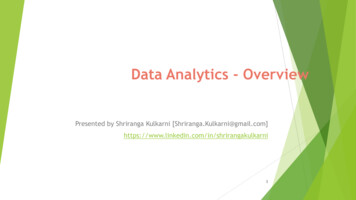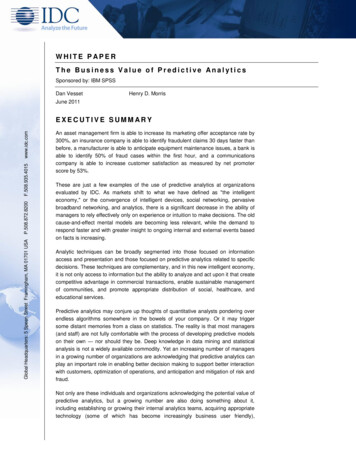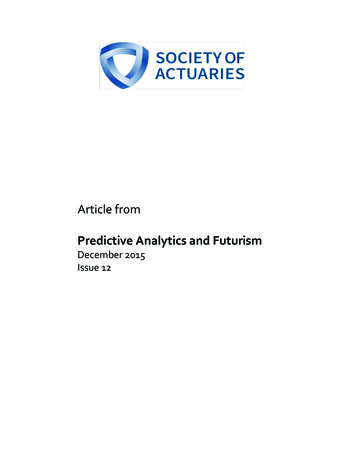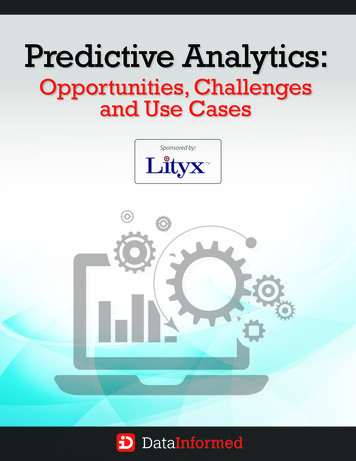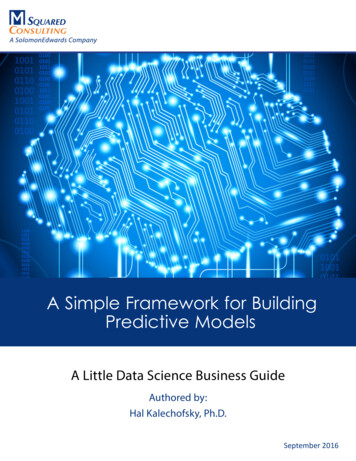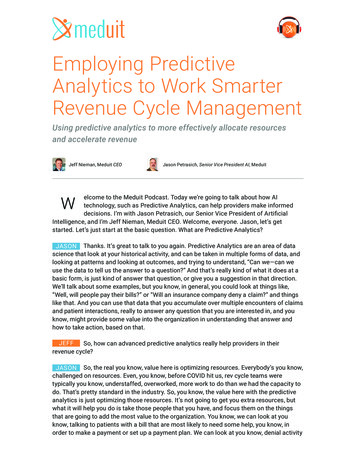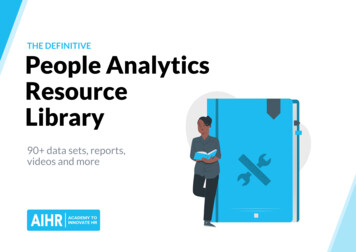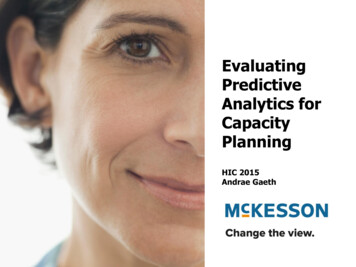
Transcription
EvaluatingPredictiveAnalytics forCapacityPlanningHIC 2015Andrae Gaeth
What is predictive analytics?Predictive analytics is the practice ofextracting information from existing data sets,and then applying various techniques (eg,statistical, modelling) in order to determinepatterns and predict future outcomes andtrends.How can we practically evaluate and usepredictive analytics solutions for capacityplanning within health?
Paradigm Shift Required for AnalyticsMaturitySources:Competing on Analytics, Tom DavenportGartner IT GlossaryWhat should I do?PrescriptiveWhat will happen?PredictiveWhat is happening?Real TimeWhy did it happen?DescriptiveWhat happened?Descriptive
What to look for with Capacity Planning1. Manages multiple planning horizons– Multi-year, annual, 6-8 week scheduling periods,weeks, days and hours2. Continuously updates forecasts3. Forecasts patient demand with consistently highabsolute accuracy vs. stated accuracy %aggregated over time4. Forecasts volumes for door-to-door patient flowvs. preset intervals and departments5. Converts forecasts automatically into capacityand staffing needs6. Supports user insight, input and adjustment aspart of the planning process
Strategic & Annual Planning Discuss “what-if” options, regional plan Budget and physical capacity decisions Set targets and assumption (linking plans)Monthly & Weekly Planning Manage “current” variation to plan Update forecasts & roster staff Informed decision makingDaily Planning Unit focus: manage current & projected pts. Focus on relieving immediate flow issues Replace sick leave? Book casual
Forecasting Methods Used for OperationalPlanningPredictive modelingAlgorithmic modelingPattern identificationScenario modelingSimulationOptimization
PredictiveDetermining, mathematically, therelationship between the explanatoryvariables and the predicted variable, basedon historical dataExamples:Insurance: relationship between certaincharacteristics of a person and lifestyleand predicted outcome of a certain claimCapacity Planning: relationship betweenstatus of ED at a given time of day andthe impact on Inpatient beds tomorrow
Pattern Identification‘Time series forecasting’ identifies different patterns within the predictedvariable itself, such as trend, seasonality and day of the week. Variouscombinations of those patterns can then be used to derive a forecast
AlgorithmicTake recent averages and distributions of past activity for certain locations,services and day of the week or special event days. Then apply analgorithm to utilize these to create a projection
ScenarioAllow users to input their own assumptions or ‘what ifs’ into the predictionto assess impacts (vs. based purely on patterns of past activity)Annual CensusAnnual Patients In201220132014201220132014201220132014Annual Patient TurnHospital 1702.42.42.2511615Activity16% 6063.0Cardiac 1,1341,030IP 2% 171,3021,1741,2003.93.43.3IP mergency31,14033,53832,9614,2654,5494,8847.37.46.7 Analyze 110,2928,9632,4102,2512,0595.04.64.4 What do we expect this year? Sustain or continue trends? What change initiatives are we investing in to increase volumes andreduce ALOS?
SimulationCoded logic which emulates the actual individual patient ADT activity ofplanned patient admissions/bookings
OptimisationUsing either a mathematical or algorithmic approach to derive the optimaloutcome, based on an ‘objective 1304/08/201304/04/2013‘Business as usual’ would haverequired 50 – 60 beds staffed;using an optimised activity planresulted in 40 - 50
Combining ApproachesHistorical DataDevelops base patient demandbased on current trends seenfrom historical data.PathwaysPatient pathways leveraged tosimulate and/or optimise anyimpact on OR’s and inpatient units.AlgorithmsAlgorithms applied to forecastincreasing accuracy of patientdemand.Clinical InputCustomers clinical expert input ofareas that may impact anypatient demand added.
Comparing Planning ApproachesAggregate vs. Patient-levelStatic vs. DynamicShort term vs multi-horizonTop down vs. Bottom up
Predictive analytics is the practice of extracting information from existing data sets, and then applying various techniques (eg, statistical, modelling) in order to determine patterns and predict future outcomes and trends. How can we practically evaluate and use predictive analytics solutions for capacity planning within health?

